Easy Olive Oil Sourdough Bread
Get ready to fall in love with Olive Oil Sourdough Bread! This beginner-friendly bread has a soft crust and the most amazing flavor!
Olive oil sourdough bread is our family’s new love affair!
By adding a little olive oil, this sourdough bread has a softer crust and so much flavor. The olive oil complements the typical sourdough flavor to produce a mellower bread with a beautifully even and moist crumb.
Even though this is a high-hydration dough, it is not difficult to make and is very beginner-friendly!
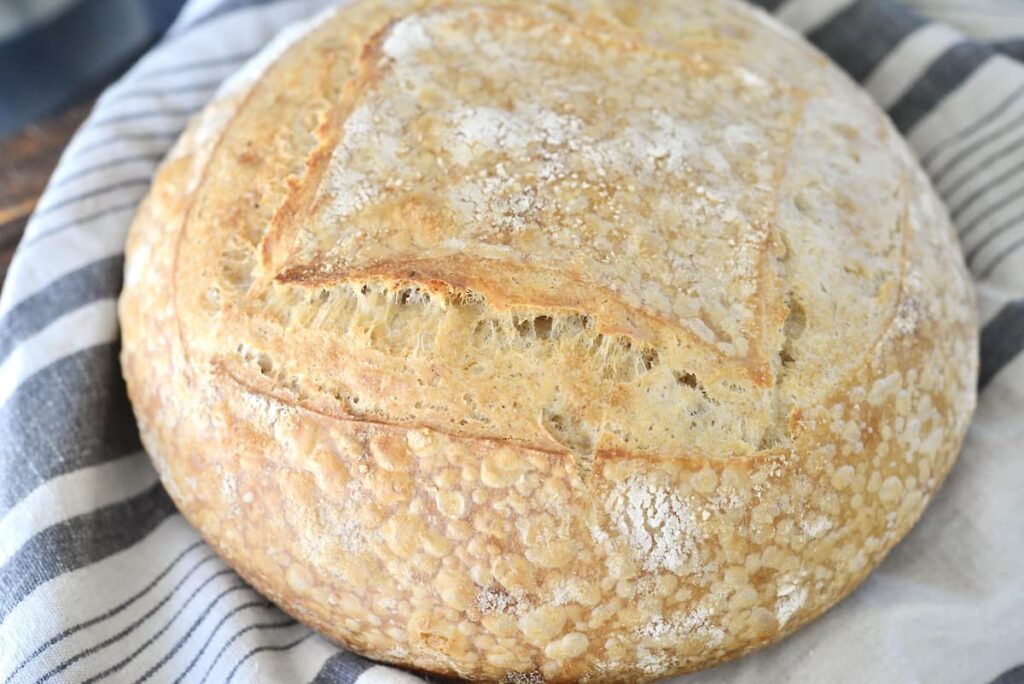
This post contains affiliate links, which means I make a small commission at no extra cost to you. You can read my full disclosure.
The Ingredients
You only need 4 ingredients for this easy sourdough bread:
- Active Sourdough Starter: If you don’t have one yet, I encourage you to check out my super simple method to make your own starter from scratch.
- Olive Oil: I love using high-quality extra virgin cooking olive oil for my sourdough bread.
- Flour: I use whatever flour I have, mostly organic all-purpose flour.
- Salt: This is my favorite sea salt but whatever you have on hand will work.
- Warm Water: Not exactly an ingredient but I thought I would mention it. Using warm water will help your dough!
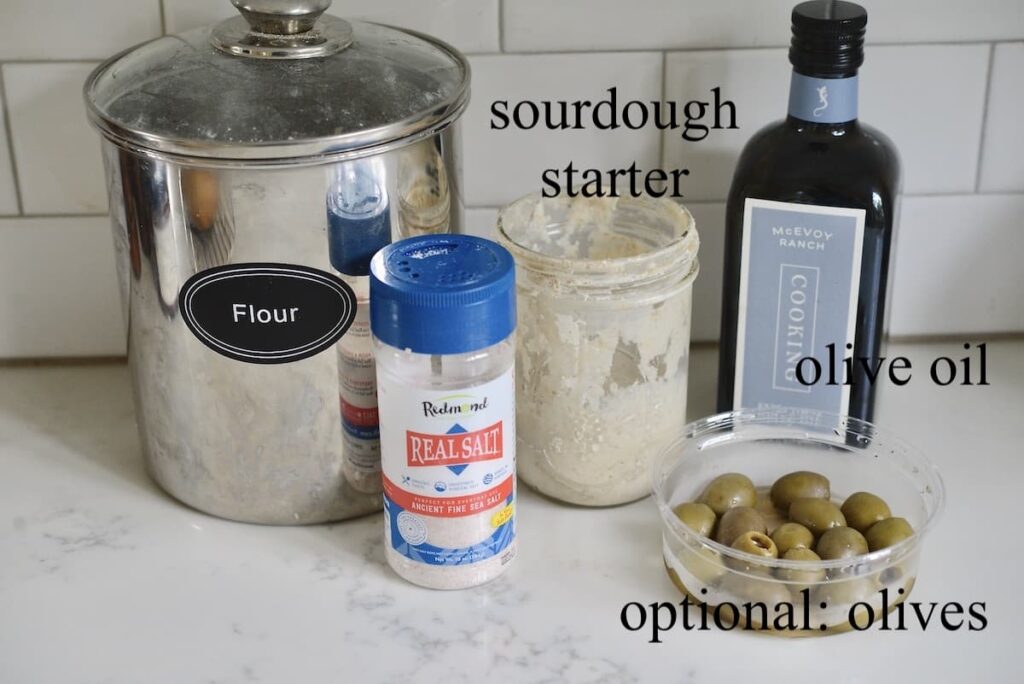
Useful Tools and Equipment
- Stand mixer: People have been making and mixing bread doughs for millennia but a stand mixer makes that so much easier.
- Digital Kitchen Scale: Weight measurements are so much more accurate than volume measurements and digital scales are very affordable if you don’t already own one.
- Banneton: These proofing baskets are very useful with or without a cloth liner. However, you can use any bowl and line it with a kitchen towel or other cloth if you don’t own a banneton.
- Dutch Oven: I love using one of my cast iron Dutch ovens. With the lid on, they perfectly trap the steam to ensure a nice rise.
- Bread Lame: While you can also use a sharp knife to score your bread, a bread lame uses a razor blade and is extremely sharp.
You can learn more about my favorite sourdough baking tools in this post.
Substitutions and Variations
This easy sourdough bread recipe is pretty flexible or the perfect launching pad for additional ingredients:
- Olives: You might like to add some chopped green olives or Kalamata olives for a nice savory bread.
- Yeast: With a good, active sourdough starter this bread will rise nicely. For extra assurance or if you have a young starter, you can add a pinch of commercial yeast.
- Flour: This bread recipe works perfectly with regular flour. However, you can use some portion of bread flour, rye flour, or whole wheat flour.
- Roasted Garlic: Adding some roasted garlic pieces works really well in this recipe.
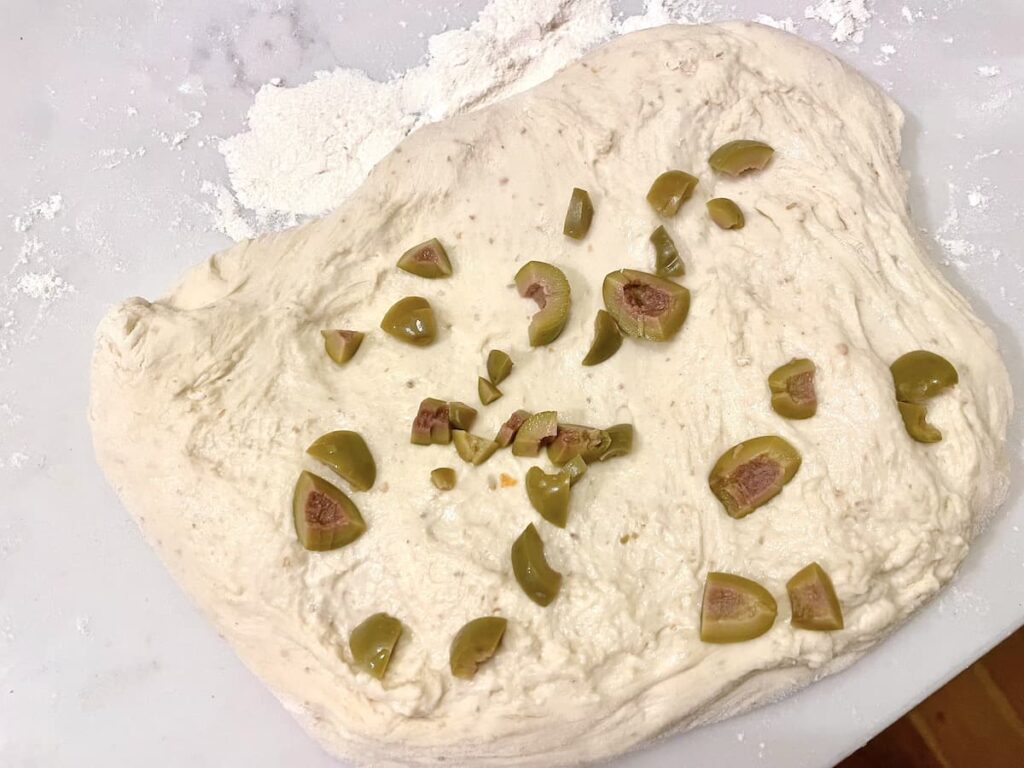
How to Serve
I don’t think you need instructions on how to eat bread, do you?
However, we love eating this bread fresh out of the oven. Having to wait until it is cool enough is often difficult but so worth it!
- Butter and salt: This is all you need and you’ll think you have just gone to heaven.
- Oil and vinegar: This olive sourdough bread is perfect when dipped into Organic Extra Virgin Olive Oil and balsamic vinegar.
- Note: You can get McEvoy Ranch’s olive oil for 10% off with my code ANJA10!
- Toasted with olive oil: Drizzle a thick slice of this bread with some olive oil and toast it in the oven for the perfect taste!
- Bruschetta: This Mediterranean classic is easy to make with this olive oil bread (you might like to try this classic Italian bruschetta mix).
- Sandwiches: Since this bread has a tighter crumb and not a lot of big holes, it is perfect for sandwiches.
- Holiday Stuffing: In the rare event that you find yourself with leftovers, this bread makes the perfect base for a sourdough bread Thanksgiving stuffing.
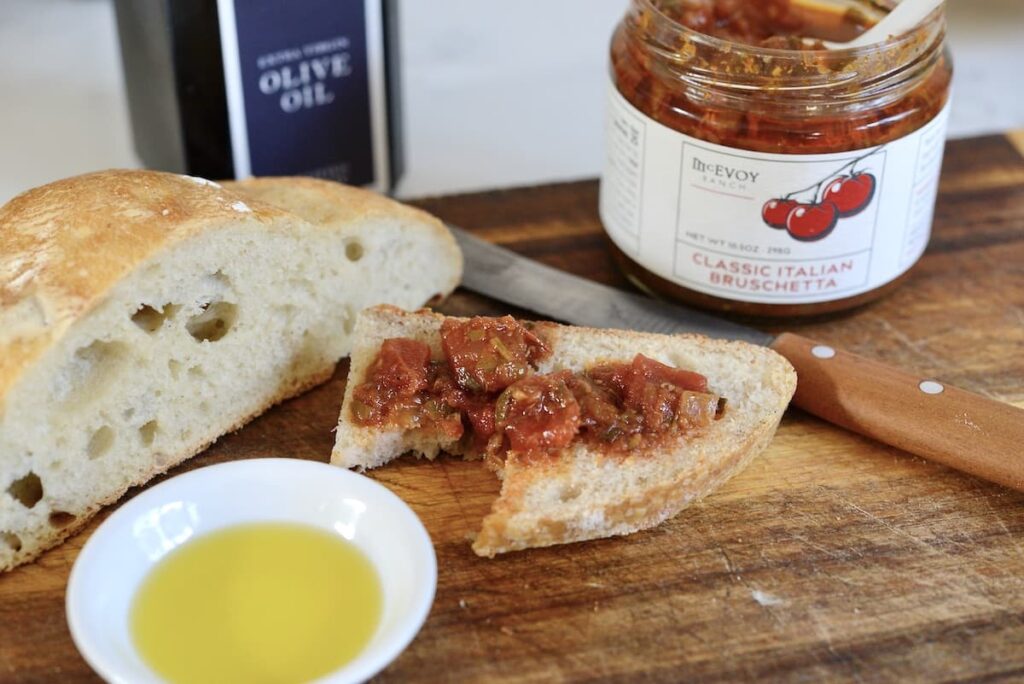
Make Ahead of Time?
There are two ways you can prepare this bread ahead of time:
- You can make the dough and let it ferment in the refrigerator for a day or two or whenever you are ready to bake.
- Alternatively, you can bake the bread and either freeze it whole or cut it in half. I recommend placing it in plastic wrap while still slightly warm and freezing it right away. You can then crisp it up in a warm oven for 15-20 minutes.
New To Sourdough? Check out My Super Simple Sourdough Course!
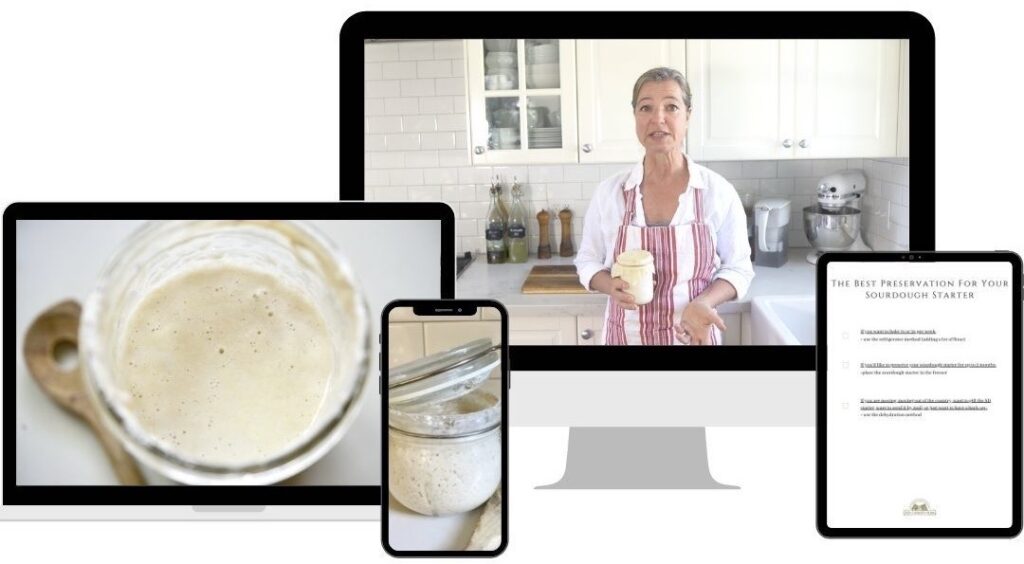
Other Sourdough Recipes You Might Like
Easiest No-Knead Sourdough Bread Ever
Make Your Own Sourdough Starter: No Measuring, No Discards, No Feeding
No Discard Way to Maintain Your Sourdough Starter
How to Make
1. Make the Dough:
- Measure and add your ripe sourdough starter with the wet ingredients to the bowl of your stand mixer or a large mixing bowl. Mix well.
- Add the dry ingredients and mix in your stand mixer for about 8 minutes. If you don’t have a stand mixer you can use a Danish dough hook to mix this dough by hand.
- It should be a somewhat shaggy dough.
NOTE: Be sure to use a mature sourdough starter for this recipe. If your starter is still young, you can add 1 g of commercial yeast to help the dough rise.
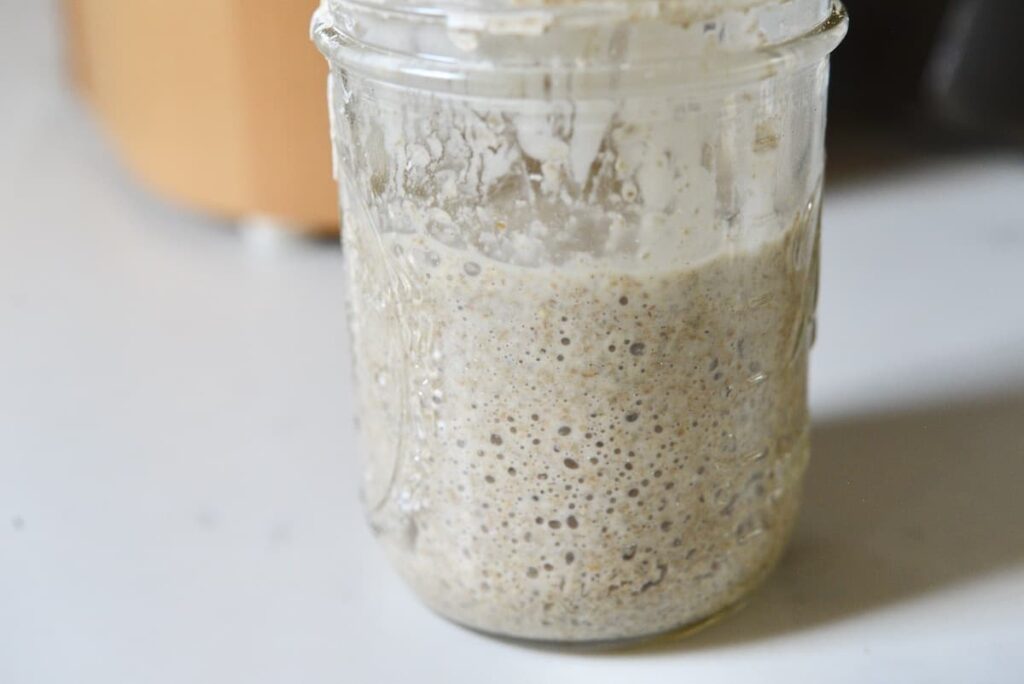
2. Bulk Fermentation, Stretch and Fold
- Cover the bowl with a clean kitchen towel and let the dough rest at room temperature for 30 minutes.
- With wet hands perform the first set of stretch and folds.
- Let the dough rest in a warm place for 30 minutes.
- Do 2 more sets of stretch and fold.
- After the third time, let the dough ferment for one hour before you do the final stretch and fold.
3. Shape the Dough
- Add some flour to your work surface.
- With a dough scraper or silicone spatula, put the dough onto the floured surface.
- Gently stretch the dough and fold it back over itself.
- Turn over the dough ball and gently pull it toward yourself while giving it a slight turn to get some tension on the surface of the dough.
4. Proof the Dough
- Heavily dust your proofing basket with flour (I like to use 50% AP flour and 50% rice flour).
- Put your shaped dough into the floured banneton with the seam side up. Cover it with a beeswax wrap or plastic wrap.
- Let it ferment in the refrigerator for at least 10 hours. You can even leave it in there for up to 48 hours.
5. Preheat the Oven and Dutch Oven
- The next morning or when you are ready to bake, preheat your oven with your Dutch oven with the lid to 450˚F for about 30 minutes.
- Remove your dough from the refrigerator after 25 minutes.
6. Score the Dough
- Remove the hot Dutch oven from your oven and remove the lid.
- Place your dough right into the hot Dutch oven. You can also place it onto a piece of parchment paper first and then lower it into the hot Dutch oven.
- With a bread lame or very sharp knife score the top of the dough in your favorite pattern.
7. Bake the Bread
- Put the lid back on to the Dutch oven and place it on the hot oven. Bake your sourdough loaf for about 25 minutes.
- Remove the lid and bake the bread for another 25 minutes or until the crust is golden brown.
- The final dough temperature should be about 200˚F.
NOTE: For best results, I put a baking tray on the lowest oven rack. That prevents the bottom of the loaf from turning too dark.
8. Cool the Bread
- When the bread is done, carefully transfer it to a cooling rack.
- Let it cool down for about 2 hours before cutting it.
Sample Schedule:
3:00 pm: Mix dough
3:15 pm: Bulk fermentation, stretch and folds
5:45 pm: Shape dough
6 pm: Second rise
8 am: Preheat the oven
8:30 am: Bake the bread
9:20 am: Cool the bread
11:20 am: Enjoy your fresh bread!
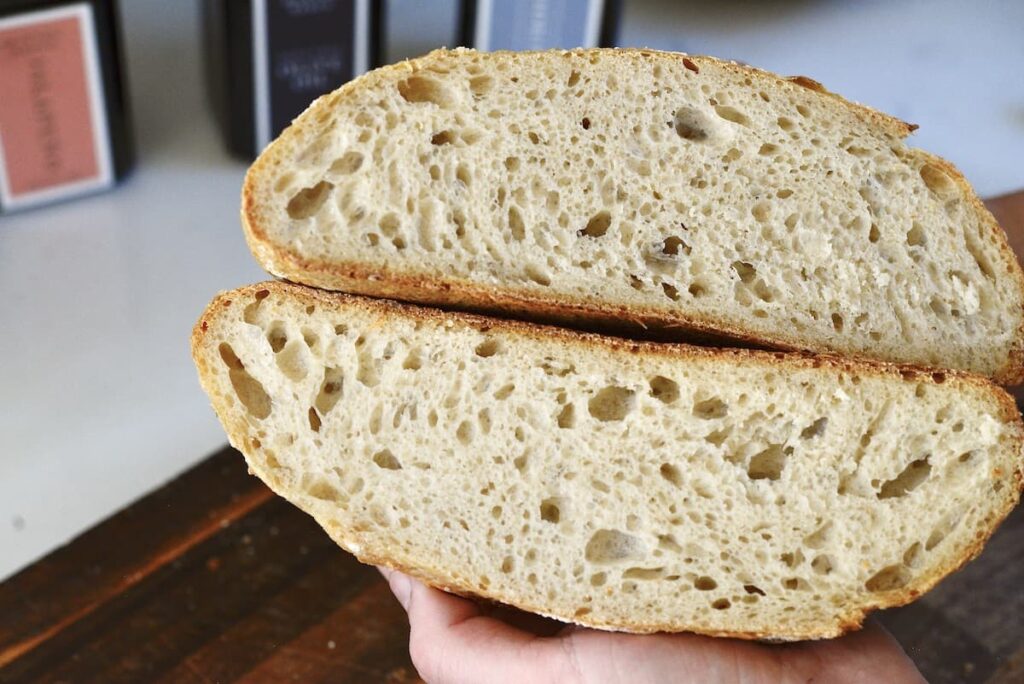
Pin For Later:
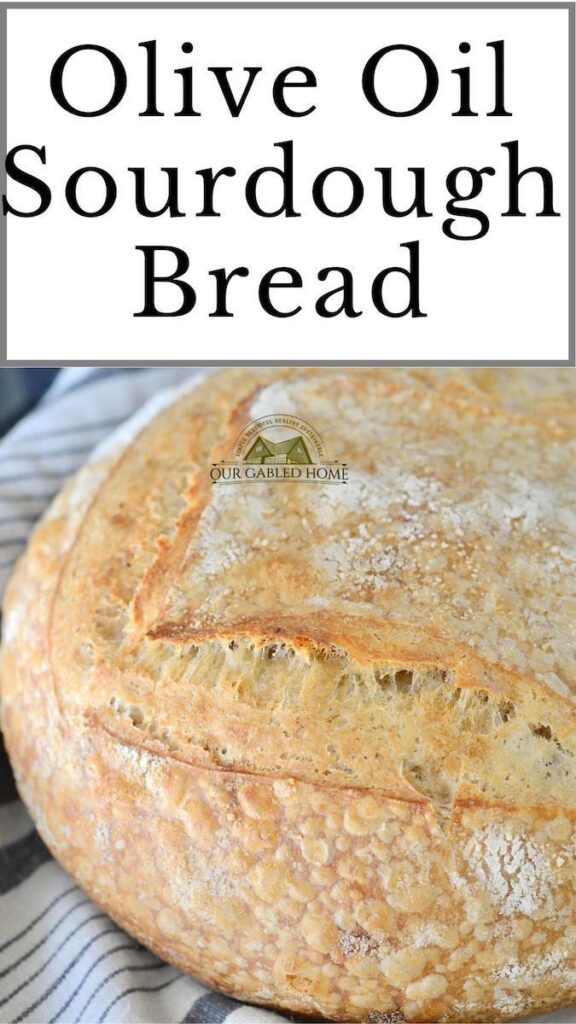
Olive Oil Sourdough Bread
Ingredients
- 125 grams active sourdough starter
- 40 grams olive oil
- 300 grams warm water
- 450 grams flour
- 10 grams salt
Instructions
- Measure and add the wet ingredients to a bowl. Mix well.
- Add the dry ingredients. Mix in a stand mixer for 8 minutes (or by hand with a Danish dough hook).
- Cover the bowl and let the dough rest for 30 minutes.
- With wet hands, perform a few stretch and folds. Cover the bowl and let the dough rest for 30 mins. Repeat this 2 more times.
- Cover the bowl and let the dough rest for 60 minutes in a warm place.
- On a floured surface, shape the dough into a round. While gently pulling the dough ball towards you and turning it slighlty, tuck the dough until you create surface tension.
- Place the dough ball seam sid up into a floured proofing basket. Cover it with a beeswax wrap or plastic wrap. Let the dough ferment in the refrigerator for 10 hours or more.
- Preheat a Dutch oven with lid in your oven to 450˚F for 30 mins.
- Remove the lid place the dough ball in the Dutch oven floured side up. Score the top of the dough with a sharp knife or bread lame.
- Bake covered for 25 mins. Remove the lid.
- Bake uncovered ror 25 mins or until golden brown.
- Let the bread cool for 2 hours on a wire rack.
Notes
- if your sourdough starter is young, you can add 1 g of commercial yeast to help with the rise
- you can also add some chopped green or black olives to the bread dough

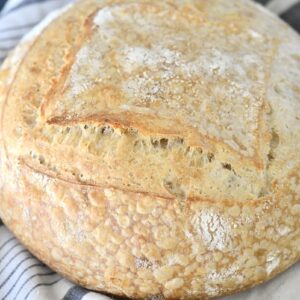
Also wondering I want to start with a cold Dutch oven so do u increase the baking time to 40 min covered per your instructions using a cold Dutch oven for a different recipe?
Yes, you can increase the baking time but you can also check the internal temperature of the bread (should be around 200˚F) ~ Anja
What size Dutch oven for this recipe? I’m torn between 5 and 6 quart and this is my first time with this recipe!
Second attempt. Keeps coming out great. Added sweet basil leaf to this batch.
Nice! I am sure it tastes great with basil ~ Anja
New to making sourdough and this is the first recipe I’ve used. Turns out great every time!
That makes me so happy to hear ~ Anja
What size Dutch oven are you using?
Mine is this Lodge combo cooker: https://amzn.to/3UdtJYu ~ Anja
I am new to sourdough and struggled to find the right texture. The dough was very wet and sticky. It broke when I tried to stretch and fold, any thoughts?
What is the four mill you have? It looks much easier and convenient than mine! I am loving following you!!
It’s a Mockmill and I love it: https://ourgabledhome.com/product/grain-mills/ Thank you so much for your sweet comment ~ Anja